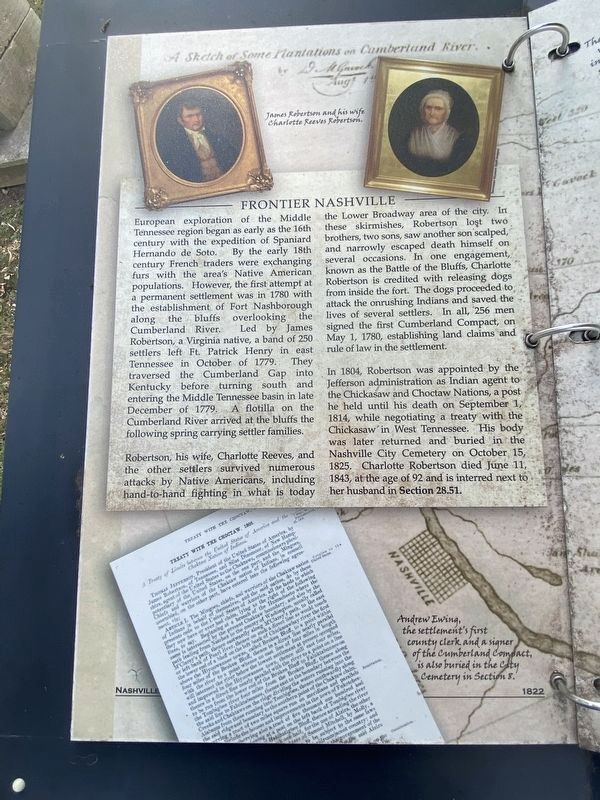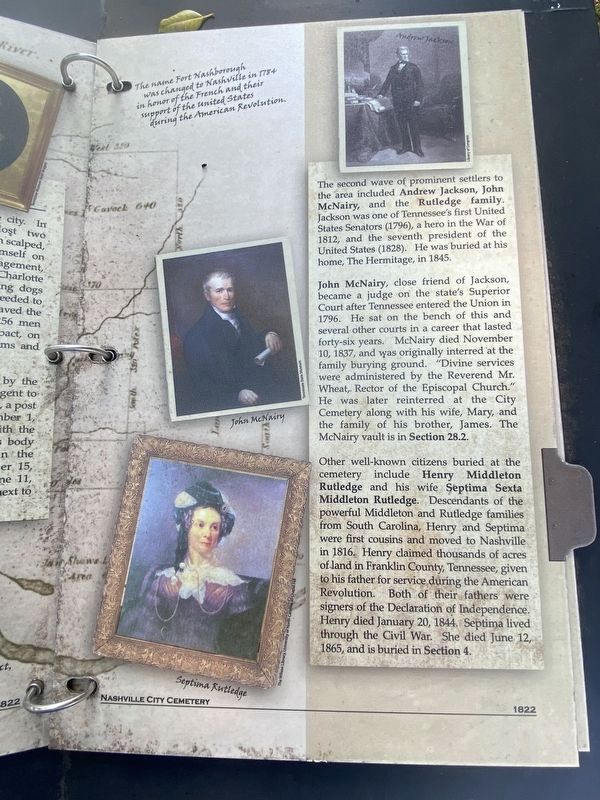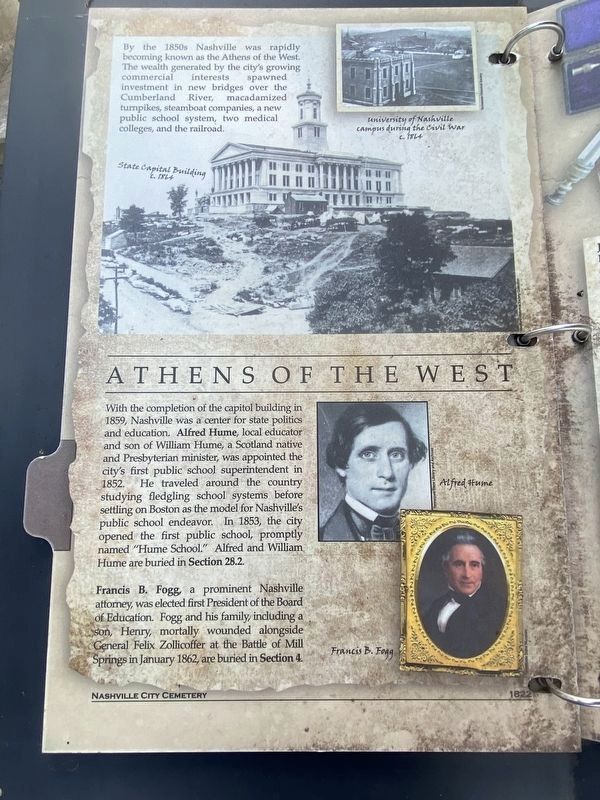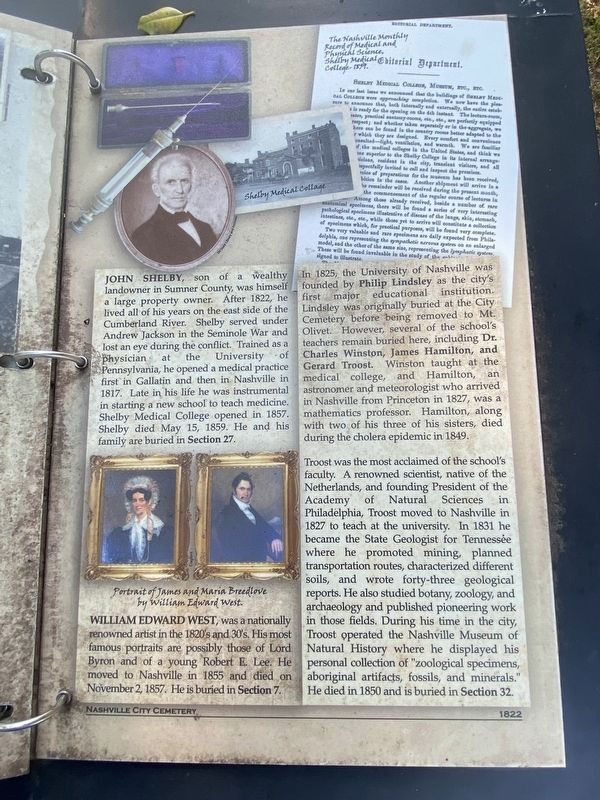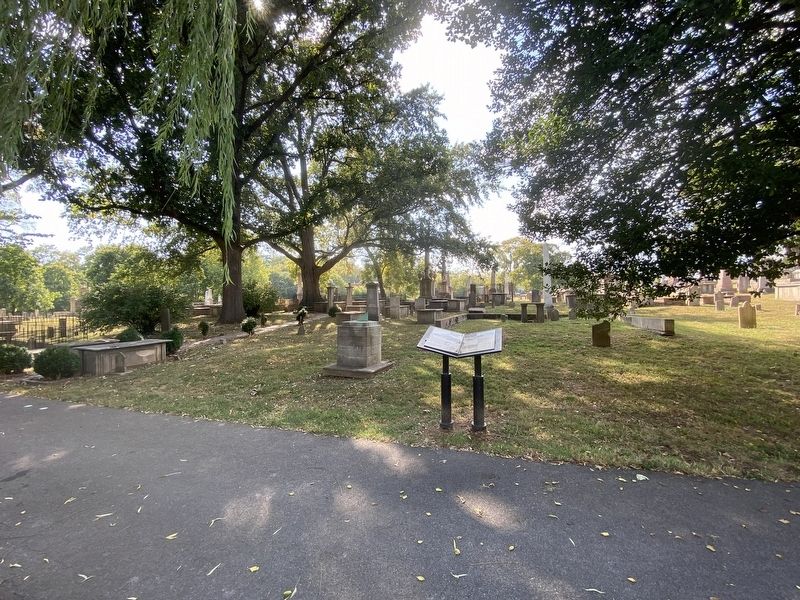South Nashville in Davidson County, Tennessee — The American South (East South Central)
Frontier Nashville / Athens of the West
European exploration of the Middle Tennessee region began as early as the 16th century with the expedition of Spaniard Hernando de Soto. By the early 18th century French traders were exchanging furs with the area's Native American populations. However, the first attempt at a permanent settlement was in 1780 with the establishment of Fort Nashborough along the bluffs overlooking the Cumberland River. Led by James Robertson, a Virginia native, a band of 250 settlers left Ft. Patrick Henry in east Tennessee in October of 1779. They traversed the Cumberland Gap into Kentucky before turning south and entering the Middle Tennessee basin in late December of 1779. A flotilla on the Cumberland River arrived at the bluffs the following spring carrying settler families. Robertson, his wife, Charlotte Reeves, and the other settlers survived numerous attacks by Native Americans, including hand-to-hand fighting in what is today the Lower Broadway area of the city. In these skirmishes, Robertson lost two brothers, two sons, saw another son scalped, and narrowly escaped death himself on several occasions. In one engagement, known as the Battle of the Bluffs, Charlotte Robertson is credited with releasing dogs from inside the fort. The dogs proceeded to attack the onrushing Indians and saved the lives of several settlers. In all, 256 men signed the first Cumberland Compact, on May 1, 1780, establishing land claims and rule of law in the settlement.
In 1804, Robertson was appointed by the Jefferson administration as Indian agent to the Chickasaw and Choctaw Nations, a post he held until his death on September 1, 1814, while negotiating a treaty with the Chickasaw in West Tennessee. His body was later returned and buried in the Nashville City Cemetery on October 15, 1825. Charlotte Robertson died June 11, 1843, at the age of 92 and is interred next to her husband in Section 28.51.
The second wave of prominent settlers to the area included Andrew Jackson, John McNair, and the Rutledge family. Jackson was one of Tennessee's first United States Senators (1796), a hero in the War of 1812, and the seventh president of the United States (1828). He was buried at his home, The Hermitage, in 1845.
John McNair, close friend of Jackson, became a judge on the state's Superior Court after Tennessee entered the Union in 1796. He sat on the bench of this and several other courts in a career that lasted forty-six years. McNairy died November 10, 1837, and was originally interred at the family burying ground. "Divine services were administered by the Reverend Mr. Wheat, Rector of the Episcopal Church." He was later reinterred at the City Cemetery along with his wife, Mary, and the family of his brother, James. The McNairy vault is in Section 28.2.
Other well-known citizens buried at the cemetery include Henry Middleton Rutledge and his wife Septima Sexta Middleton Rutledge. Descendants of the powerful Middleton and Rutledge families from South Carolina, Henry and Septima were first cousins and moved to Nashville in 1816. Henry claimed thousands of acres of land in Franklin County, Tennessee, given to his father for service during the American Revolution. Both of their fathers were signers of the Declaration of Independence. Henry died January 20, 1844. Septima lived through the Civil War. She died June 12, 1865, and is buried in Section 4.
With the completion of the capitol building in 1859, Nashville was a center for state politics and education. Alfred Hume, local educator and son of William Hume, a Scotland native and Presbyterian minister, was appointed the city's first public school superintendent in 1852. He traveled around the country studying fledgling school systems before settling on Boston as the model for Nashville's public school endeavor. In 1853, the city spend the first public school, promptly named "Hume School." Alfred and William Hume are buried in Section 28.2
Francis B. Fogg,a prominent Nashville attorney, was elected first President of the Board of Education. Fog and his family, including a son, Henry, mortally wounded alongside general Felix Zollicoffer, at the Battle of Mill Springs in January 1862, are buried in Section 4.
John Shelby, son of a wealthy landowner in Sumner County, was himself a large property owner. After 1822, he lived all of his years on the east side of the Cumberland River. Shelby served under Andrew Jackson in the Seminole War and lost an eye during the conflict. Trained as a physician at the University of Pennsylvania, he opened a medical practice first in Gallatin and then in Nashville in 1817. Late in his life he was instrumental in starting a new school to teach medicine. Shelby Medical College opened in 1857. Shelby died May 15, 1859. He and his family are buried in Section 27.
In 1825, the University of Nashville was founded by Phillip Lindsley as the city's first major educational institution Lindsley was originally buried at the City Cemetery before being removed to Mt. Olivet. However, several of the schools teachers remain buried here, including Dr. Charles Winston, James Hamilton, and Gerard Troost. Winston taught at the medical college, and Hamilton, an astronomer and meteorologist who arrived in Nashville from Princeton in 1827, was a mathematics professor. Hamilton, along with two of his three sisters, died during the cholera epidemic in 1849.
Troost was the most acclaimed of the school's faculty. A renowned scientist, native of the Netherlands, and founding President of the Academy of natural Sciences in Philadelphia, Troost moved to Nashville in 1827 to teach at the university. In 1831 he became the State Geologist for Tennessee where he promoted mining, planned transportation routes, characterized different soils, and wrote forty-three geological reports. he also studied botany, zoology, and archaeology and published pioneering work in those fields. During his time in the city, Troost operated the Nashville Museum of natural History where he displayed his personal collection of "zoological specimens, aboriginal artifacts, fossils, and minerals." he died in 1850 and is buried in Section 32.
Topics. This historical marker is listed in this topic list: Settlements & Settlers.
Location. 36° 8.837′ N, 86° 46.194′ W. Marker is in Nashville, Tennessee, in Davidson County. It is in South Nashville. Marker can be reached from 4th Avenue South (Alternate U.S. 31). Located within the Nashville City Cemetery. Touch for map. Marker is at or near this postal address: 1001 4th Ave S, Nashville TN 37210, United States of America. Touch for directions.
Other nearby markers.
At least 8 other markers are within walking distance of this marker. From Frontier to Civilization (within shouting distance of this marker); Nashville City Cemetery (within shouting distance of this marker); A Community of Citizens and Soldiers (within shouting distance of this marker); John E. Hagey (within shouting distance of this marker); The Civil War and Its Aftermath (within shouting distance of this marker); William Carroll (within shouting distance of this marker); The Free and the Unfree (within shouting distance of this marker); Andrew Ewing (about 300 feet away, measured in a direct line). Touch for a list and map of all markers in Nashville.
Credits. This page was last revised on February 7, 2023. It was originally submitted on October 4, 2022, by Darren Jefferson Clay of Duluth, Georgia. This page has been viewed 110 times since then and 16 times this year. Photos: 1, 2, 3, 4, 5. submitted on October 4, 2022, by Darren Jefferson Clay of Duluth, Georgia. • Mark Hilton was the editor who published this page.
